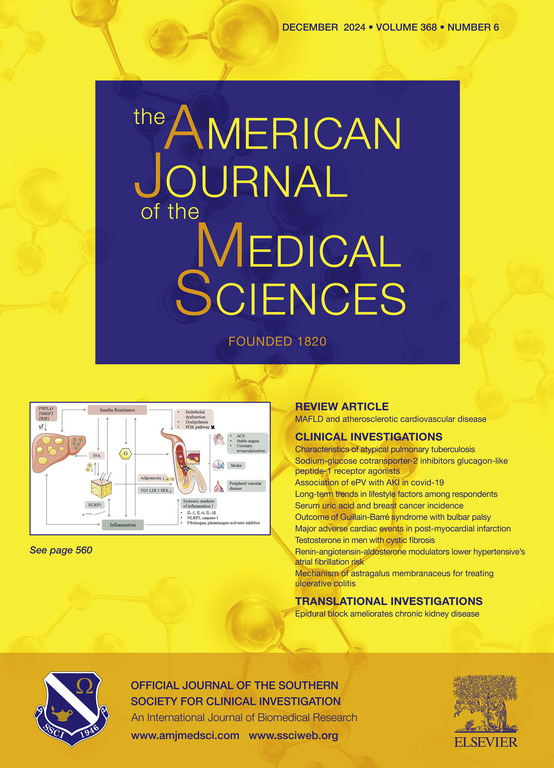Utility of arterial to end-tidal carbon dioxide gradient as a severity index in critical care
IF 1.8
4区 医学
Q2 MEDICINE, GENERAL & INTERNAL
引用次数: 0
Abstract
Background
The arterial to end-tidal carbon dioxide gradient (P [a-Et] CO2) reveals the ventilation-perfusion (V/Q) status of critically ill patients. V/Q mismatch has several causes and affects the clinical outcomes of critically ill patients. We investigated the relationship between P (a-Et) CO2 and the clinical outcomes in critically ill patients.
Methods
Critically ill patients (n = 1,978) on mechanical ventilation and capnography in the intensive care units of two institutions were enrolled and categorized into three groups: P (a-Et) CO2 ≤10 mmHg (low group), 10 mmHg < P (a-Et) CO2 ≤ 20 mmHg (medium group), and 20 mmHg < P (a-Et) CO2 (high group).
Results
The Acute Physiology and Chronic Health Evaluation II score was 29.5 ± 8.1, 31.3 ± 8.2, and 33.3 ± 8.7 in the low, medium, and high groups, respectively (p < 0.001). Overall mortality rates were 25.5 %, 35.6 %, and 52.8 % in the low, medium, and high groups, respectively (p < 0.001). The odds ratio was 1.456 (95 % confidence interval [CI]: 1.117–1.897, p = 0.002) and 2.320 (95 % CI: 1.635–3.293, p < 0.001) for the medium and high groups, respectively, with the low group as a reference. The area under the receiver operating characteristic curve of P (a-Et) CO2 for overall mortality was 0.604 (p < 0.001).
Conclusions
P (a-Et) CO2 is a simple, easily accessible indicator that potentially impacts patient care and outcomes as an independent marker for assessing disease severity and predicting mortality, especially in non-respiratory critical care scenarios.
动脉与潮气末二氧化碳梯度作为重症监护严重程度指数的实用性。
背景:动脉与潮气末二氧化碳梯度(P [a-Et] CO2)显示了重症患者的通气-灌注(V/Q)状态。V/Q 不匹配有多种原因,会影响危重病人的临床预后。我们研究了 P (a-Et) CO2 与重症患者临床预后之间的关系:方法:我们选取了两家医院重症监护室中使用机械通气并接受二氧化碳呼气检测的重症患者(1 978 人)为研究对象,并将其分为三组:P (a-Et) CO2 ≤ 10 mmHg(低组)、10 mmHg < P (a-Et) CO2 ≤ 20 mmHg(中组)和 20 mmHg < P (a-Et) CO2(高组):低、中、高组的急性生理学和慢性健康评估 II 评分分别为 29.5 ± 8.1、31.3 ± 8.2 和 33.3 ± 8.7(P < 0.001)。低、中、高组的总死亡率分别为 25.5%、35.6% 和 52.8%(P < 0.001)。以低度组为参照,中度组和高度组的几率比分别为 1.456(95% 置信区间 [CI]:1.117-1.897,p = 0.002)和 2.320(95% CI:1.635-3.293,p < 0.001)。总死亡率 P (a-Et) CO2 的接收器操作特征曲线下面积为 0.604(p < 0.001):P (a-Et) CO2是一个简单、易用的指标,作为评估疾病严重程度和预测死亡率的独立标志物,它可能会对患者护理和预后产生影响,尤其是在非呼吸危重症护理情况下。
本文章由计算机程序翻译,如有差异,请以英文原文为准。
求助全文
约1分钟内获得全文
求助全文
来源期刊
CiteScore
4.40
自引率
0.00%
发文量
303
审稿时长
1.5 months
期刊介绍:
The American Journal of The Medical Sciences (AJMS), founded in 1820, is the 2nd oldest medical journal in the United States. The AJMS is the official journal of the Southern Society for Clinical Investigation (SSCI). The SSCI is dedicated to the advancement of medical research and the exchange of knowledge, information and ideas. Its members are committed to mentoring future generations of medical investigators and promoting careers in academic medicine. The AJMS publishes, on a monthly basis, peer-reviewed articles in the field of internal medicine and its subspecialties, which include:
Original clinical and basic science investigations
Review articles
Online Images in the Medical Sciences
Special Features Include:
Patient-Centered Focused Reviews
History of Medicine
The Science of Medical Education.

 求助内容:
求助内容: 应助结果提醒方式:
应助结果提醒方式:


